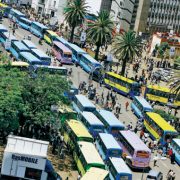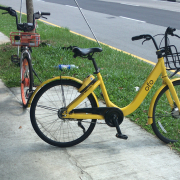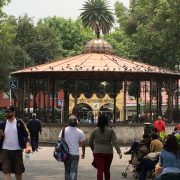AN ODE TO NAIROBI TRANSIT: PART II
By David Leipziger MURP/MBA ’17
Part of my job in Nairobi this summer is gathering data on the matatu industry and operations all over town. It has afforded me the opportunity to immerse myself in the city’s mass transit system. Thus, in my second installment on transit, I want to make some bold assertions, criticisms, and recommendations for the matatu sector. I will speak to four areas that need improvement: payment, vehicles, service, and urban policy.
To be clear: this is not a polemic for or against matatus. I am not an expert (yet). But there are some lessons that I think can be learned and improvements that can have widespread benefits.
1) Payment
Fares on matatus are paid exclusively through onboard cash payment. It is possible to use the mobile-based MPESA system, but only due to its prevalence among individuals rather than institutionalization.
And yet, since December 2014, all matatus are required by law to use a cashless fare payment system. The regulatory body, Kenya’s National Transport Safety Administration (NTSA), wanted to streamline payment, reduce fare manipulation, and appear modern. But the cashless conversion failed and, instead of changing regulations, authorities instead choose not to enforce the requirements.
Why did cashless payment not work? There are four main reasons. First, it prevented most matatu operators from skimming cash off of daily revenues. Second, the available cashless technologies were flawed: they were expensive (and paid for by operators), inefficient (with some requiring PIN codes, slowing the payment process), and not inter-operable (there were at least six different systems to choose from). Third, standardized digital fares prevent operators from charging based on traffic conditions.
The industry protested based on these factors and killed the cashless requirement. The problem now is that notoriously corrupt police can fine any matatu for “non-compliance.”
The solution to making cashless payment work is to pair a single, vetted payment system with related regulations. A single firm can buy rights to cashless infrastructure, but it must be fast, inexpensive, and be tailored to operator needs (e.g. allow for geo-tagging to allow for distance-based pricing). The city must make concessions to the industry to improve efficiency of operations. For example, creating matatu-only lanes on major roads, improving station/stage infrastructure, and cracking down on the ubiquity of police demanding bribes from operators. Only with some preserved benefits will the matatu industry accept an otherwise onerous cashless system.
2) Vehicles
Matatus come in many sizes. The most common vehicle is a Japanese-made 14-seater minibus, but 34- and 40-seaters are increasingly prevalent. Partly, this is due to Kenya’s Integrated National Transport Policy. According to the policy, 14-seaters are no longer being issued matatu licenses after January 1, 2011.
Ostensibly this policy hopes to phase these vehicles out because they are perceived as the most dangerous and law-breaking. It is true that 14-seaters are more often in accidents and offer less comfortable rides; large matatus typically have padded seats, standard fares, payment receipts, etc. The city also wants to reduce matatu traffic, so a citywide fleet of few large vehicles is preferable to many small vehicles.
But this policy is shortsighted, particularly with the plans for public transit on the horizon. First, the 14-seaters are more efficient vehicles. Because matatus only leave their terminal when full, the smaller vehicles can operate on faster headways. Second, smaller vehicles serve routes with lower volumes that are not worth a firm investing in with larger vehicles. These are the same routes that serve the least accessible and isolated populations. And third, when public transit is introduced, public vehicles will operate along the most heavily trafficked routes; they will not compete with the smaller, supplementary routes. The 14-seater fleet will be sorely needed to complement public transit corridors.
Instead of banning 14-seaters, Nairobi should embrace them and plan with them. The strategies from the previous section will also help to improve operating standards by reducing operators’ costs. Over time, it should be possible to balance tighter regulations with performance-improving concessions.
3) Service requirements
Nairobians lament that matatu services operate on short and radial routes. Getting from East to North or East to West requires a transfer, typically downtown. But matatu routes are not arbitrary; they are profit-maximizing. Since the matatu industry is all privately planned and operated, routes that don’t turn a profit are not pursued.
The prevailing business model for operations focuses on high-volume, short distance trips. Prices are kept low with competition, so the only way to earn more is to complete more trips. This explains why matatu operators can be so discriminatory to certain trip-takers, drive so aggressively, and don’t operate long, circumferential routes. This is also why public transit is needed: to provide trips that might not be as profitable (at least up-front), in order to serve important markets, needs, and populations.
But public transit also has operations options. The route I have worked on, the Ndovu BRT corridor that will be Nairobi’s first public transit line, will operate along the A104 highway. The exclusive-lane BRT infrastructure will run for about 20 kilometers. The service options are: (a) a trunk-and-feeder structure where BRT buses follow the exclusive infrastructure and feeder buses ferry passengers to transfer points at the corridor’s termini; or (b) a direct service system, where BRT-compatible buses serve local streets and then enter into the exclusive infrastructure, providing a longer, one-seat ride.
Current wisdom prefers the former because local streets are assumed to be too congested and too beaten up for BRT-quality buses. My research, however, has proven that traffic speeds during the morning peak are typically only 10% slower than free-flow speeds along these corridors; the maximum delay is only four minutes. In come cases, there is no difference. Moreover, road quality is either quite good (as good as Nairobi has to offer) or bad only in parts that could be avoided without avoiding actual communities. Nairobi should pursue a direct service operations plan for the Ndovu Line BRT. It will attract more riders, reduce capital costs, and provide improved service to local streets.
4) Urban Policy
A final note on urban policy. The matatu industry, as I’ve mentioned, is highly regulated. The NTSA is constantly creating new requirements, regulations, and policies targeting the transport sector. No doubt, their efforts are motivated by sincere urges to improve traffic conditions and increase mobility for all (particularly the poor). But they ignore one of the most critical policy levers.
We cannot change transport outcomes without addressing housing. The local and national government need to consider how land use and housing policy affect mobility and access. The matatu industry is a grind because its most dependent users are low-income residents of the urban periphery, because Nairobi’s CBD has practically no housing, and because there is not enough space for matatu parking or stations. These are all real estate issues. Urban policy must focus on these issues form a housing and land perspective to make substantive changes to urban mobility.












Leave a Reply
Want to join the discussion?Feel free to contribute!